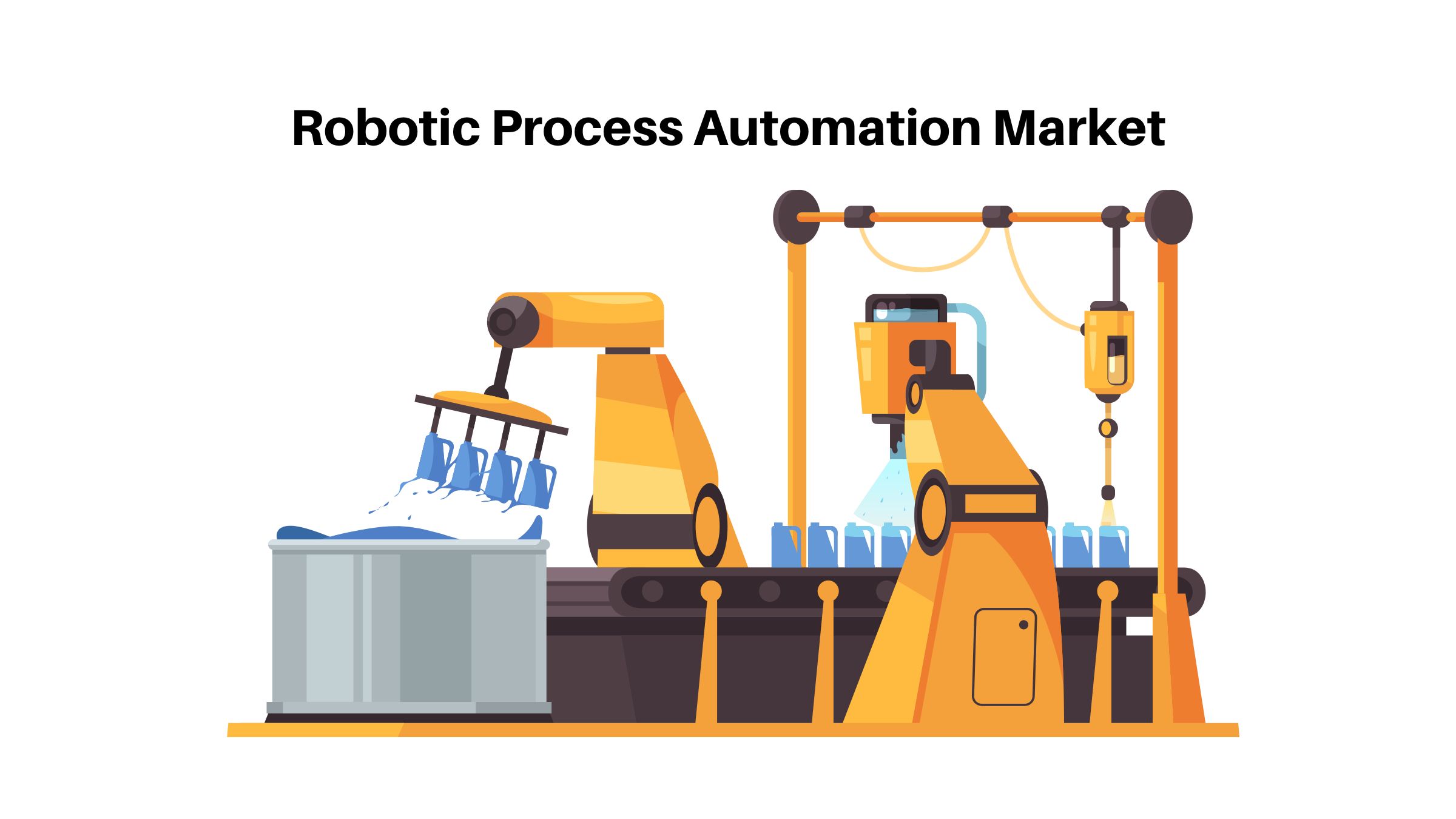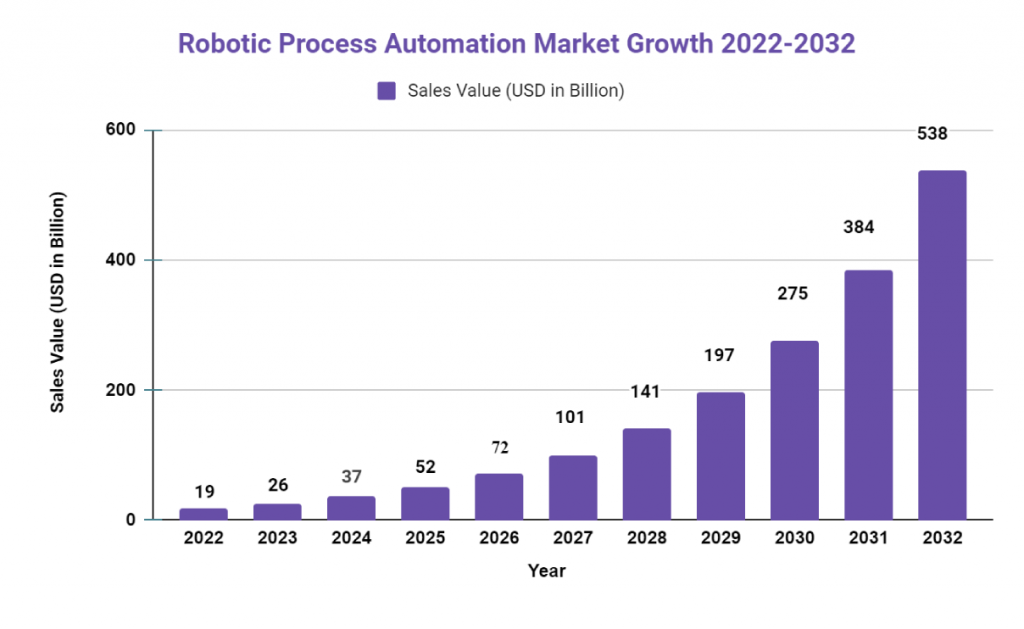Robotic Process Automation Market Economic Growth (CAGR of 39.8%)

Page Contents
Introduction
Published Via 11Press: Robotic Process Automation Market: Robotic Process Automation (RPA) is a rapidly growing technology that has been gaining momentum in the enterprise market. The RPA market is projected to be a multi-billion dollar industry by 2025, as organizations around the world seek to automate back office operations and improve operational efficiency while cutting costs. This article provides an introduction to the RPA market, including its growth trends and key players in this space.
The Worldwide robotic process automation market was worth USD 18.85 billion in 2022. It is expected to grow at a compound annual rate (CAGR of 39.8%) between 2022 and 2032.
RPA promises to reduce manual labor by automating mundane tasks such as data entry, customer service inquiries and invoicing. It also streamlines processes such as lead generation and business intelligence analysis, allowing companies to focus on more strategic initiatives. As demand for RPA increases, leading companies are investing heavily in research & development activities so they can deliver innovative solutions for their customers.

Key Takeaways
- In 2022, the global robotic process automation market was valued at USD 18.85 billion.
- By 2032, analysts forecast the robotic process automation market to generate USD 538 billion in revenue.
- Between 2022 and 2032, it is forecast to grow at a compound annual rate (CAGR) of 39.8%.
- The service segment held a commanding 62.89% share of the global market, and this trend is expected to continue into the future.
Cloud-based deployment models have seen a meteoric rise in popularity, now accounting for more than 60% of the RPA market share. - By 2021, the BFSI sector is projected to account for 27.6% of GDP worldwide. Banks and other financial institutions can use RPA technology to streamline their business processes such as account opening, deposit taking, and loan lending.
- North America had been responsible for 36.5% of the revenue share in recent years.
- RPA adoption has grown rapidly over these last few years, with many companies now integrating RPA into their operations.
- Major players in the RPA market include Automation Anywhere, Blue Prism, UiPath, WorkFusion and others.
Do Inquiry Before Buying This Report Here: https://market.us/report/robotic-process-automation-market/#inquiry
RPA promises to reduce manual labor by automating mundane tasks such as data entry, customer service inquiries and invoicing. It also streamlines processes such as lead generation and business intelligence analysis, allowing companies to focus on more strategic initiatives. As demand for RPA increases, leading companies are investing heavily in research & development activities so they can deliver innovative solutions for their customers.
Regional Analysis
- North America is currently the largest market for RPA solutions, followed by Europe and Asia Pacific.
- Asia Pacific is expected to be the fastest-growing market for RPA, due to the increasing adoption of automation technologies in the region and the presence of a large number of outsourcing companies.
- The adoption of RPA solutions is also increasing in emerging markets such as Latin America, the Middle East, and Africa.
Market Dynamics
Drivers:
- Increasing demand for business process automation: The need for increased efficiency, accuracy, and cost savings in business processes is driving the demand for robotic process automation (RPA) solutions.
- Advancements in artificial intelligence and machine learning: Advancements in artificial intelligence and machine learning are enabling the development of more sophisticated RPA solutions that can automate complex business processes.
- Rapid digital transformation: The ongoing digital transformation of many industries is driving the adoption of RPA solutions, as companies seek to automate manual and repetitive tasks.
- Cost savings: RPA can help companies to reduce labor costs, improve operational efficiency, and increase productivity, which is driving demand for RPA solutions.
- RPA Industry to Experience Growth Due to Increased Adoption of AI, Machine Learning and Cloud
The market growth of robotic process automation will be primarily driven by the increasing adoption of advanced technologies like AI, machine learning and cloud. More businesses are turning to RPA to automate business processes and manage complex data. Companies are developing cloud-based and AI-based RPA solutions in order to automatically optimize processes and workflows.
However, infrastructure and customization issues related to RPA could pose a limiting factor for the market in the coming years.
Restraints:
- Limited awareness and understanding of RPA: Many companies are still not aware of RPA solutions or do not fully understand their capabilities and benefits, which can limit adoption of RPA.
- Integration with existing systems: Integrating RPA solutions with existing systems can be complex and time-consuming, which can create challenges for companies seeking to implement RPA.
- Security and privacy concerns: The use of RPA solutions can create security and privacy concerns, particularly when sensitive data is involved.
Opportunities:
- Emerging markets: Emerging markets offer significant growth opportunities for the RPA market, as companies in these regions are increasingly adopting automation solutions to increase efficiency and productivity.
- Healthcare industry: The healthcare industry presents a significant opportunity for RPA solutions, as there are many manual and repetitive processes that can be automated to improve patient care and reduce costs.
- Process automation for small and medium-sized enterprises (SMEs): RPA solutions can help small and medium-sized enterprises to automate business processes and improve efficiency, which can be particularly beneficial for companies with limited resources.
Challenges:
- Competition from other automation technologies: RPA solutions face competition from other automation technologies such as artificial intelligence, machine learning, and chatbots.
- Resistance to change: Resistance to change can be a challenge for companies seeking to implement RPA, particularly if employees are resistant to automation and fear job loss.
- Scalability: The scalability of RPA solutions can be a challenge, particularly for companies with complex and large-scale business processes.
Robotic Process Automation Market Trends
- Increased Adoption by Small and Medium-sized Enterprises (SMEs): Small and medium-sized enterprises (SMEs) are increasingly adopting RPA solutions, realizing its potential to streamline operations and boost efficiency.
- Increased Demand for RPA Service Providers: There is an increasing need for RPA service providers who specialize in creating, deploying and managing RPA solutions.
- Enhancing Security Measures: Organizations are placing greater emphasis on security measures in their RPA solutions to safeguard sensitive data.
- Focus on User Experience: Organizations are placing greater emphasis on improving the user experience of RPA solutions, making them more intuitive and user-friendly.
- Increased Investment in RPA Development: Organizations are investing heavily in the creation of RPA solutions, realizing its potential to revolutionize their operations.
- Adoption and Rapid Growth in the Healthcare Sector: Healthcare organizations are rapidly adopting RPA solutions, realizing its potential to enhance patient care and streamline operations.
- Retail Sector Adoption of RPA Solutions: Retailers are increasingly adopting RPA solutions, realizing its potential to enhance customer experiences and boost efficiency.
- Increased Demand for Low-Code Platforms: There is a rising need for low-code platforms that make it possible for non-technical users to develop and deploy RPA solutions.
Acquire This Report At Discounted Rate: https://market.us/purchase-report/?report_id=12861
Recent Developments
- The COVID-19 pandemic has accelerated the adoption of RPA solutions, as companies seek to automate manual and repetitive tasks and reduce the need for physical labor.
- The integration of RPA solutions with other automation technologies such as artificial intelligence and machine learning is becoming more common, enabling the development of more sophisticated and effective automation solutions.
- The use of cloud-based RPA solutions is becoming more popular, as it allows companies to quickly and easily scale their automation capabilities and reduces the need for on-premise infrastructure.
- The RPA market is seeing consolidation, as larger companies acquire smaller RPA vendors to expand their automation capabilities and offer more comprehensive solutions.
- The focus on security and data privacy is increasing in the RPA market, as companies seek to ensure that their automation solutions are secure and compliant with data protection regulations.
Market Segmentation
By Type
- Software
- Service
- Consulting
- Implementing
- Training
By Application
- BFSI
- Pharma & Healthcare
- IT and Telecom
- Other Applications
Маrkеt Kеу Рlауеrѕ
- Automation Anywhere
- Blue Prism PLC
- EdgeVerve Systems Ltd.
- FPT Software
- KOFAX, Inc.
- NICE
- NTT Advanced Technology Corp.
- OnviSource, Inc.
- Pegasystems
- UiPath
- Other Key Players
Report Scope
| Report Attribute | Details |
| The market size value in 2022 | USD 18.85 Bn |
| Revenue forecast by 2032 | USD 537.51 Bn |
| Growth Rate | CAGR Of 39.8% |
| Regions Covered | North America, Europe, Asia Pacific, Latin America, and Middle East & Africa, and Rest of the World |
| Historical Years | 2017-2022 |
| Base Year | 2022 |
| Estimated Year | 2023 |
| Short-Term Projection Year | 2028 |
| Long-Term Projected Year | 2032 |
Contact us
Contact Person: Mr. Lawrence John
Market.us (Powered By Prudour Pvt. Ltd.)
Tel: +1 718 618 4351
Send Email: [email protected]
The team behind market.us, marketresearch.biz, market.biz and more. Our purpose is to keep our customers ahead of the game with regard to the markets. They may fluctuate up or down, but we will help you to stay ahead of the curve in these market fluctuations. Our consistent growth and ability to deliver in-depth analyses and market insight has engaged genuine market players. They have faith in us to offer the data and information they require to make balanced and decisive marketing decisions.


